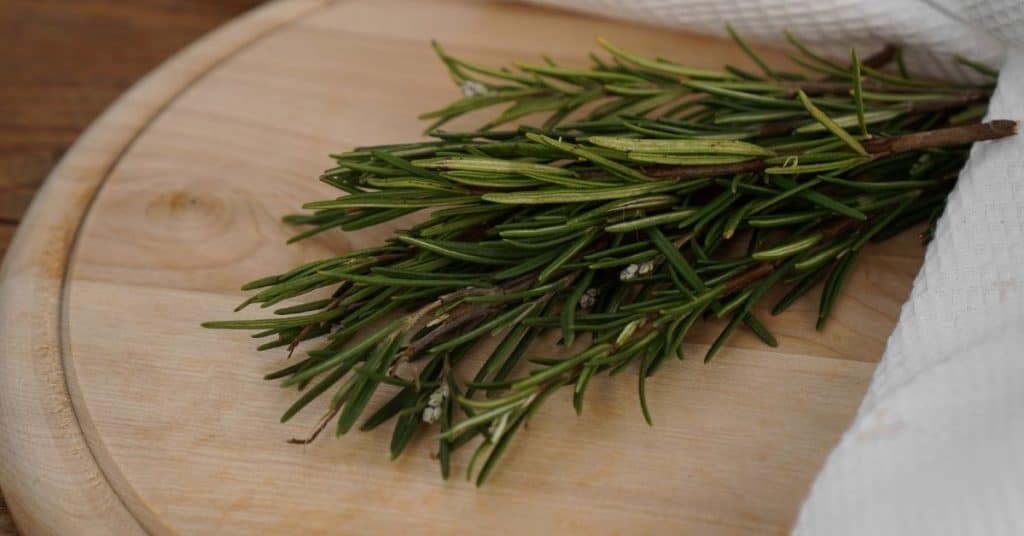Briefly, there are two methods to dry rosemary: air drying and oven drying. Both methods require cleaning and trimming the rosemary sprigs before dehydrating them.
Rosemary is a hardy herb used mainly in cooked savory dishes. It is popular in comforting home-cooked meals such as lamb roasts, stews, roasted vegetables, and garlic and herb bread.
This delicious fresh herb lasts up to 2 weeks in the refrigerator. If you have more rosemary than you can use in your favorite rosemary recipes, drying is a great way to preserve fresh rosemary. This way you can use them for up to 3 years.
Follow the guide below to find out everything you need to know about drying rosemary.
Can You Dry Rosemary?
Yes, you can dry rosemary, and it’s pretty easy. A warm, dry climate provides the ideal drying conditions for the herb. If you live in a very humid area, it is best to use heat-drying methods such as the oven method.
Humidity and moisture in the air can lead to mold forming before the herb has a chance to dry out completely.
Drying fresh rosemary by hanging has the longest drying time and can take up to 2 weeks. Air drying is, however, the best way to preserve the flavor of this aromatic herb.
Once dehydrated and packed into air-tight containers, store dried rosemary in a cool, dark, and dry place away from direct sunlight (such as a kitchen cupboard or spice cabinet).
How To Dry Rosemary
Preparation: Cleaning
Regardless of the method you choose to dehydrate rosemary, it needs to be trimmed and cleaned first.
Step 1: Cut rosemary stems into similar lengths. Discard any yellow, brown, or moldy bits.
Step 2: Lightly rinse the leaves in cold water.
Step 3: Place the rosemary sprigs on a clean paper towel and gently pat dry. All the excess moisture from washing should be dried before you start the dehydration process.
After drying the leaves with paper towels, leave them to air dry further for a few minutes if needed. Decide whether you want to air-dry or oven-dry the leaves and follow the instructions below accordingly.
Method 1: Air Drying
Step 1: Form Bundles
Gather a few sprigs of rosemary and tie them together at the base of the stem with a rubber band or piece of string. Don’t tie more than 5 to 8 sprigs per bundle to allow even airflow and drying.
Step 2: Hang
Choose a well-ventilated area with good light to hang the rosemary bundles. Avoid areas that are moist such as spaces near a stove. Avoid drying the herbs in direct sunlight as this may cause some flavor loss.
Pierce a paper bag with holes and cover the rosemary bundles with the bag. This will protect the bundles from dust but still allow sufficient airflow through. Do not use a plastic bag as this will not allow sufficient airflow and cause mold.
The drying process can take up to 2 weeks depending on the climate. When the rosemary leaves are brittle, dry, and easily fall off the stem when handled they are ready.
Tip: Use a clothes hanger to hang the bundles from.
Step 3: Pack
Take the dried rosemary sprigs down. Working over a bowl or plate, remove leaves by running your fingertips down the stem. The leaves should break easily.
You can crush the rosemary into smaller pieces with a mortar and pestle if you wish. Smaller pieces are more palatable and release optimal flavor.
Step 4: Store
Store rosemary in a glass jar or airtight containers and label with the date and contents.
Note: When drying rosemary, it is important to make sure that it is completely dry before packing the herbs. Mold will develop if moisture is present, even inside your packaging. If the leaves are still pliable and don’t break easily, they need more drying time.
Method 2: Oven-Drying
Step 1: Preheat Oven
Preheat the oven to its lowest temperature setting around 110 °F (43 °C).
Step 2: Prepare Leaves
When using the oven, you can pick the leaves off the woody stems before starting. Place the cleaned rosemary leaves in a single layer on a baking sheet lined with parchment paper. Do not overcrowd the baking sheet.
Step 3: Bake
Place the tray of rosemary in the oven. The rosemary will be dried out completely between 2 and 4 hours. The length of time required will depend on the climate as well as the oven type.
The leaves should have a hard texture, break apart from each other easily and become brittle when they are completely dehydrated.
Step 4: Store
Let the dried rosemary cool for a few minutes. Crush them into smaller pieces if desired. Store the dried rosemary in resealable plastic bags, spice bottles, or an airtight container. Label with the date and contents.
Tip: Use a food dehydrator instead of the oven. Dehydrating rosemary on dehydrator trays will take 6 to 8 hours on a low setting.
Types of Rosemary
Rosemary varieties are divided into 2 main categories. The plant grows as an upright shrub or as a ground cover. Within these categories, there are many different types of rosemary of which not all are used for cooking.
Scented rosemary, with its excellent flavor and soft leaves, is the most common type used for culinary purposes along with Blue Boy, Spice Islands, and White rosemary. The evergreen shrubs have needle-like leaves flowering in white, blue, pink, or purple blossoms.
Rosemary pairs well with most types of meat, pork, and poultry as well as roast vegetable dishes, stews, and soups.
Its flavor and hardiness make it a great herb for use in barbecue fare. The herb is also used to infuse herbal notes into butter, oil, and rosemary tea.
FAQs
Properly dehydrated rosemary will last 1 to 3 years if kept in cool, dry conditions.
If you are using dried rosemary instead of fresh, only use one-third of the recommended amount. If your recipe calls for one tablespoon of fresh rosemary, you can use one teaspoon of dried rosemary instead.
To avoid a long drying time, you can dry rosemary quickly in the microwave. However, this is not the best method for optimal flavor preservation. Place the rosemary sprigs in a single layer between two paper towels.
Microwave on high heat for 4 minutes. If the leaves are not fully dehydrated after 4 minutes, continue to microwave them in 30-second intervals.
Yes, you can dry rosemary on the stem. Hanging the rosemary in bundles upside down in a warm, well-ventilated area allows it to dry naturally and retain its flavor and aroma.
Conclusion
There are several methods to dry fresh rosemary and add flavor to your cooking or baking for many more months. The ideal climate for drying herbs is a dry, warm area. It should be light and have good air ventilation, however, be out of full sun.
Always make sure the leaves are completely dehydrated before packing to ensure their longevity. Dried rosemary will serve you well in summer barbecues and cozy winter foods bringing a great taste of comfort to the table.
Check more guides on how to dry dill, thyme, mint and sage.
See more: What to substitute for rosemary

*image by Brill/depositphotos









